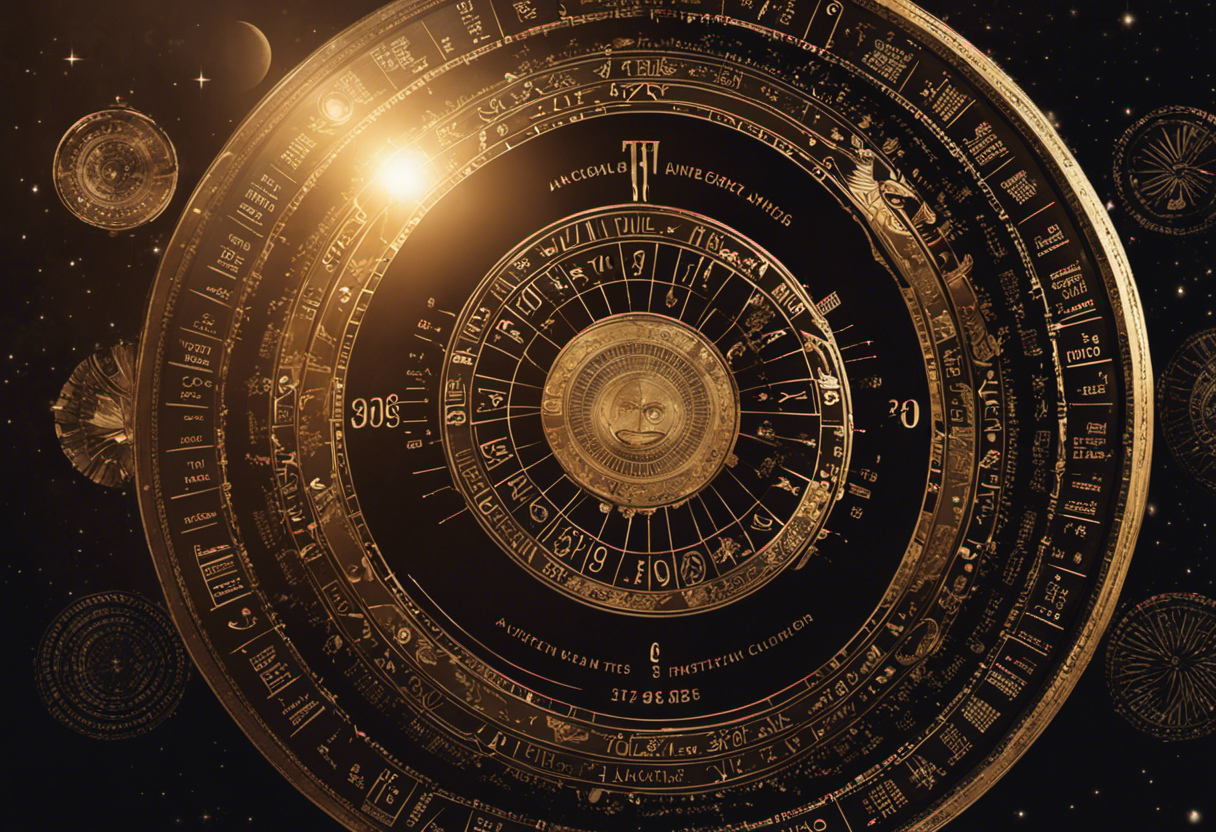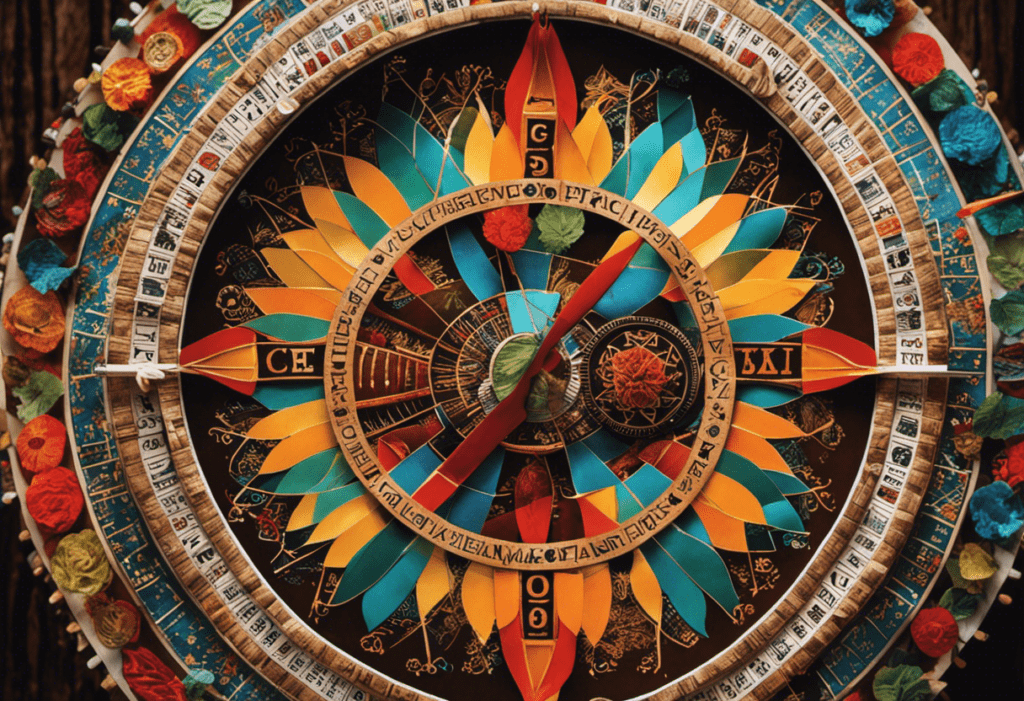The Cherokee Lunar-Solar Calendar is a celestial tapestry that weaves together ancient wisdom, astronomical observations, and cultural traditions. Like a guiding constellation in the night sky, this remarkable calendar serves as a compass, navigating the rich tapestry of Cherokee culture and heritage.
In this deep dive, we will explore the origins, components, and significance of the Cherokee Lunar-Solar Calendar, shedding light on its role in shaping the rhythm of Cherokee life and the efforts to preserve this precious cultural heritage.
Key Takeaways
- The Cherokee Lunar-Solar Calendar is a highly sophisticated calendar system developed by the Cherokee people in the southeastern United States, blending lunar and solar cycles.
- The calendar divides the year into 13 months based on specific lunar phases, allowing for optimal timing of agricultural activities and increasing the chances of successful crops.
- Lunar phases and seasons play a crucial role in guiding not only agricultural activities but also ceremonies, rituals, and spiritual practices within the Cherokee culture.
- Astronomy is essential for the development and functionality of the calendar, with celestial bodies used to determine the optimal timing for agriculture, navigation, and establishing trade networks.
Origins of the Cherokee Lunar-Solar Calendar


The origins of the Cherokee Lunar-Solar Calendar can be traced back to ancient indigenous knowledge and cultural practices. The Cherokee people, who have inhabited the southeastern United States for thousands of years, developed a deep understanding of the natural world and its cycles. Their calendar system was highly sophisticated and relied on the observation of celestial bodies, particularly the moon and the sun.
Cultural practices played a crucial role in the development of the Cherokee Lunar-Solar Calendar. The Cherokee people believed in the interconnectedness of all things and saw themselves as part of a larger cosmic order. Their calendar was not merely a tool for tracking time but also a reflection of their spiritual beliefs and a guide for important cultural events.
The Cherokee Lunar-Solar Calendar was based on the lunar month, which corresponds to the time it takes for the moon to complete one orbit around the Earth. However, the calendar also incorporated solar observations to account for the slight discrepancy between the lunar and solar years. This harmonious blend of lunar and solar cycles allowed the Cherokee people to synchronize their agricultural activities with the changing seasons and to plan their religious ceremonies in alignment with cosmic forces.
The Components of the Cherokee Lunar-Solar Calendar


The Cherokee Lunar-Solar Calendar is comprised of several key components that govern the timing of important events and rituals in Cherokee culture.
These components include the lunar phases and seasons, which are closely observed and integrated into the calendar system.
The cultural significance of these components is evident in the rituals and ceremonies that are tied to specific lunar and solar events.
Additionally, the calendar has a direct influence on daily life, guiding activities such as farming, hunting, and gathering.
Lunar Phases and Seasons
Lunar phases and seasons play a crucial role in the functioning of the Cherokee lunar-solar calendar. The calendar is deeply intertwined with agricultural practices, as the Cherokee people heavily relied on farming for sustenance and survival. By observing the lunar phases, they were able to determine the optimal times for planting, harvesting, and various agricultural activities. The lunar-solar calendar divided the year into 13 months, with each month corresponding to a specific lunar phase. This allowed the Cherokee to align their agricultural practices with the natural cycles of the moon, maximizing their chances of successful crops. The following table highlights the correlation between lunar phases and agricultural activities in the Cherokee lunar-solar calendar:
| Lunar Phase | Agricultural Activity |
|---|---|
| New Moon | Clearing land and preparing for planting |
| First Quarter Moon | Planting |
| Full Moon | Harvesting |
Cultural Significance and Rituals
Cultural significance and rituals surrounding the observation of lunar phases and seasons contribute to the rich tapestry of traditional practices within the Cherokee indigenous community. These cultural practices have evolved over time, reflecting the historical evolution of the Cherokee lunar-solar calendar.
The Cherokee people have long relied on the lunar phases and seasons to guide their agricultural activities, ceremonies, and spiritual practices. The phases of the moon are seen as symbolic representations of renewal, growth, and transformation, while the changing seasons mark important milestones in the natural world.
Rituals associated with these lunar phases and seasons serve as a means for the Cherokee to connect with their ancestors, their land, and the spiritual forces that govern their lives. These cultural practices are deeply rooted in the Cherokee identity and continue to be cherished and passed down through generations.
Influences on Daily Life
Incorporating the observations of lunar phases and seasons into daily routines allows for a greater understanding and harmony with the natural world. The Cherokee lunar-solar calendar has a profound influence on various aspects of daily life, including agriculture and social gatherings.
-
Influence on agriculture: The Cherokee people closely track the lunar phases to determine the optimal time for planting and harvesting crops. They believe that aligning agricultural activities with the lunar calendar leads to better yields and overall success in farming.
-
Impact on social gatherings: The lunar calendar also plays a significant role in determining the timing of important social events and gatherings within the Cherokee community. Festivals, ceremonies, and celebrations are often scheduled in alignment with specific lunar phases, allowing for a deeper connection to ancestral traditions and cultural practices.
Overall, the incorporation of lunar observations into daily life among the Cherokee people demonstrates their deep appreciation for the natural world and their desire to live in harmony with its rhythms and cycles.
The Role of Astronomy in the Cherokee Lunar-Solar Calendar


Astronomy plays a crucial role in the development and functionality of the Cherokee lunar-solar calendar. The Cherokee people, like many other indigenous cultures, relied heavily on the observation of celestial bodies to understand and navigate their environment.
In terms of agriculture, the Cherokee used astronomical events to determine the optimal timing for planting and harvesting crops. By observing the positions of the sun, moon, and stars, they could align their agricultural activities with natural cycles, maximizing their chances of a successful harvest.
Furthermore, celestial navigation was an essential skill for the Cherokee. By studying the movements of celestial bodies, they could determine their location and navigate vast territories. This knowledge allowed them to travel long distances and establish trade networks with other tribes.
In addition to agriculture and navigation, astronomy also played a vital role in timekeeping for the Cherokee people. The lunar-solar calendar, which was based on the cycles of the moon and the sun, helped them organize their daily activities and plan for important events such as ceremonies and gatherings. By tracking the positions of celestial bodies, they could accurately determine the passage of time and synchronize their activities with the natural world.
Overall, the incorporation of astronomy into the Cherokee lunar-solar calendar demonstrates their deep understanding of celestial phenomena and their ability to utilize this knowledge for practical purposes in agriculture, navigation, and timekeeping.
Seasonal Festivals and Observances in the Cherokee Lunar-Solar Calendar


Seasonal festivals and observances hold a significant role in the Cherokee Lunar-Solar Calendar, serving as cultural markers and opportunities for community gatherings. These festivals are intricately linked to the lunar-solar alignment, with specific dates and activities determined by celestial observations.
Traditional observance practices, passed down through generations, offer insights into the rich cultural heritage and spiritual beliefs of the Cherokee people.
Cultural Significance of Festivals
The festivals in the Cherokee lunar-solar calendar hold immense cultural significance and serve as important markers of community identity and heritage. These cultural traditions are deeply rooted in the history and spirituality of the Cherokee people. The festivals are not only community celebrations but also opportunities to honor ancestors, connect with nature, and pass down traditional knowledge to younger generations.
-
Ancestor Honoring: Many festivals in the Cherokee lunar-solar calendar involve ceremonies and rituals to honor and remember ancestors. This practice strengthens the sense of belonging and reinforces the importance of family ties within the community.
-
Nature Connection: The festivals also serve as a way for the Cherokee people to connect with nature. They celebrate the changing seasons, the cycles of the moon, and the natural elements that sustain their livelihoods. This connection to nature is deeply ingrained in Cherokee culture and their understanding of the world.
-
Cultural Preservation: The festivals play a crucial role in preserving and passing down traditional knowledge and customs. Through storytelling, dances, songs, and other artistic expressions, the Cherokee people ensure that their cultural heritage is transmitted to future generations, maintaining a sense of identity and continuity.
Lunar-Solar Alignment Explained
Lunar-solar alignment is a phenomenon that occurs when the cycles of the moon and the sun synchronize, creating a unique astronomical event. This alignment holds great significance in the development of lunar solar calendars throughout history.
Many ancient civilizations recognized the connection between the moon and the sun’s movements and their impact on the Earth. By observing and tracking these celestial bodies, ancient societies were able to develop calendars that accurately predicted the changing seasons and agricultural cycles.
The historical development of lunar solar calendars is a testament to the importance of lunar-solar alignment in human societies. Understanding this alignment allows us to appreciate the scientific and cultural significance it holds, as well as the profound impact it has had on the development of timekeeping systems.
Traditional Observance Practices
In various cultures around the world, traditional observance practices have been deeply rooted in the careful observation of celestial phenomena. The Cherokee people, for instance, developed a lunar-solar calendar that guided their agricultural, ceremonial, and social activities. This calendar was based on a deep understanding of the movements of the moon and the sun, which were believed to influence the cycles of life and the spiritual well-being of the community.
The traditional observance practices of the Cherokee involved three key elements:
-
Celestial Observation: The Cherokee closely monitored the position and phases of the moon and the sun, as well as other celestial events such as eclipses and meteor showers. These observations helped them determine the optimal times for planting, harvesting, and conducting sacred ceremonies.
-
Rituals and Ceremonies: Traditional practices included various rituals and ceremonies that honored the celestial bodies and sought their blessings and guidance. These rituals were deeply intertwined with the spiritual beliefs of the Cherokee, connecting the physical world with the spiritual realm.
-
Oral Tradition: The traditional knowledge and practices associated with celestial observation were passed down through generations via oral tradition. Elders and spiritual leaders played a crucial role in preserving and transmitting this knowledge, ensuring its continuity and relevance in the community.
These traditional observance practices not only provided practical guidance for the Cherokee’s daily lives but also fostered a deep spiritual connection with the celestial world, reinforcing their spiritual beliefs and sense of interconnectedness with the universe.
The Significance of the Cherokee Lunar-Solar Calendar in Cherokee Culture


A fundamental aspect of Cherokee culture, the significance of the Cherokee lunar-solar calendar cannot be overstated. Deeply rooted in their cultural traditions and spiritual beliefs, the calendar plays a crucial role in guiding the Cherokee people’s daily lives and ceremonial practices.
The Cherokee lunar-solar calendar is a testament to the deep connection the Cherokee people have with nature and their surroundings. It serves as a tool for tracking the cycles of the moon and the sun, allowing them to align their spiritual practices and ceremonies with the natural world. This calendar not only helps them determine the timing of important events but also provides a framework for understanding the interconnectedness of all living beings.
Furthermore, the calendar serves as a repository of traditional knowledge and wisdom. It contains valuable information about the seasons, the movement of celestial bodies, and the best times for planting and harvesting crops. Through careful observation and transmission of this knowledge across generations, the Cherokee people have been able to sustain their agricultural practices and maintain a harmonious relationship with the land.
Modern Adaptations and Preservation Efforts of the Cherokee Lunar-Solar Calendar


One way the Cherokee people are ensuring the continued relevance and preservation of their traditional calendar is through the development of modern adaptations that integrate technological advancements and traditional knowledge. These efforts reflect a commitment to honoring their cultural heritage while embracing the benefits of modern technology.
Mobile Applications:
The Cherokee Nation has developed mobile applications that allow individuals to access the lunar-solar calendar on their smartphones or tablets. These apps provide users with information about important dates and events in the Cherokee calendar, ensuring that the knowledge and practices associated with it are easily accessible to a wider audience.
Online Resources:
The Cherokee people have created websites and online platforms dedicated to their lunar-solar calendar. These platforms provide comprehensive information about the calendar, including its history, significance, and rituals. They also offer interactive features such as virtual ceremonies and workshops, allowing individuals from all over the world to engage with and learn about the calendar.
Educational Programs:
The Cherokee Nation has implemented educational programs and workshops that aim to teach younger generations about their traditional calendar. By integrating modern teaching methods and technologies, these programs ensure that the knowledge and practices associated with the calendar are passed down to future generations.
These modern adaptations and preservation efforts are crucial in maintaining the relevance and significance of the Cherokee lunar-solar calendar in contemporary Cherokee culture.
Conclusion
The Cherokee Lunar-Solar Calendar is a remarkable cultural and astronomical achievement that has played a significant role in the Cherokee culture for centuries. Its origins, components, and seasonal festivals showcase the deep connection the Cherokee people have with the natural world.
This ancient calendar system continues to be preserved and adapted in modern times, highlighting its enduring importance. The Cherokee Lunar-Solar Calendar stands as a testament to the rich history and resilience of the Cherokee people, captivating audiences with its intricate and awe-inspiring traditions.




